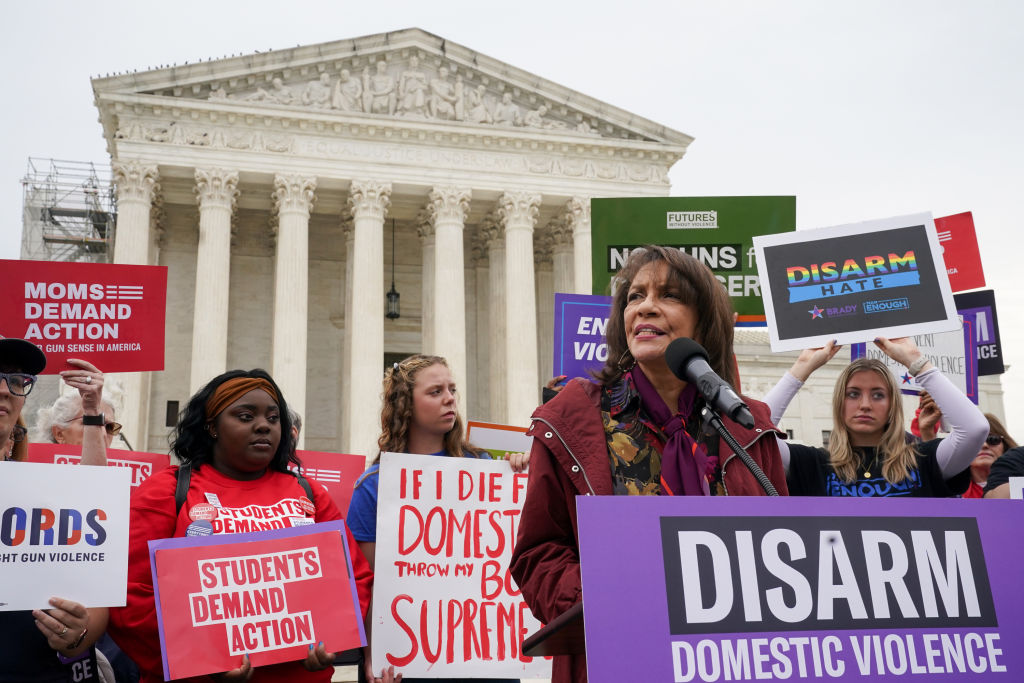U.S. v. Rahimi begs the Supreme Court to choose women’s lives over guns. Even if Rahimi loses, women won’t win.

“The Feminists should be careful in their meddling with nature. There are 300 million firearms in this country, and most of them are owned by guys,” wrote self-proclaimed “anti-feminist lawyer” Roy Den Hollander in an online manifesto.
Like Zackey Rahimi—the domestic abuser at the center of the highly consequential Second Amendment case currently pending before the Supreme Court—Den Hollander threatened his intimate partner with a gun and was subjected to a protective order as a result. Also like Rahimi, Den Hollander subsequently committed additional acts of gun violence against other individuals.
On July 19, 2020, Den Hollander showed up with a gun at the New Jersey home of Esther Salas, a federal judge who had presided over one of his numerous lawsuits and with whom he had become obsessed. Den Hollander shot and killed Salas’ son and critically wounded her husband before committing suicide. In the writings he left behind, Den Hollander portrayed women as sexually promiscuous, power-hungry demons who “murder incipient beings” through abortion; thankfully, he wrote, “men still have a monopoly on firearms in this society.”
Every 14 hours in the U.S., a man uses a gun to kill his intimate partner.
U.S. v. Rahimi is a “humiliating” case for the conservative Supreme Court majority because it demonstrates the same disturbing insight as Den Hollander’s manifesto: that men use guns to coerce, control and kill women.
The facts of Rahimi reveal the gendered and destructive reality of gun use behind the illusion of abstract, idealized self-defense.
- Every 14 hours in the U.S., a man uses a gun to kill his intimate partner.
- Pregnant women are particularly vulnerable: Homicide, principally committed by men with firearms, is the leading cause of death of pregnant women.
- Women are five times more likely to die in homes where guns are present.
- Men are twice as likely to own guns than women and are far more likely to use guns against women in a household than the reverse.
- Armed domestic abusers also bring death and destruction to the wider public: More than half of all mass shootings between 2014 and 2019 were connected to domestic abuse, and nearly two-thirds of mass shooters have a history of intimate partner violence.
Rahimi is the opposite of the noble protector of hearth and home invoked in the Court’s previous Second Amendment cases; he and his gun themselves constitute the threat to life.
This is why it is possible, some commentators have speculated, that the Court may rule against Rahimi, despite the conservative majority’s staunchly expansionist Second Amendment commitments.
During oral arguments, some conservative justices seemed receptive to solicitor general Elizabeth Prelogar’s skillful argument: Prelogar said that while there is no “historical twin” of the federal restriction at issue in this case, history and tradition support the temporary disarmament of individuals who are “not responsible”—that is, those whose possession of firearms present unusual danger of harm to others or to themselves. Domestic abusers who have engaged in multiple unlawful acts, Prelogar argued, surely qualify.
Given that women weren’t considered part of ‘we the people’ at either the time of the founding or at the time of the adoption of the 14th Amendment, the Court’s ‘history and tradition’ test would seem to require a ruling in Rahimi’s favor.
But the conservative majority’s commitment to “life” is highly selective, to put it mildly, and tends to value women’s lives—including those of domestic violence victims—very little.
When the Court in Dobbs took the extraordinary step of overruling Roe and 50 years of precedent on the right to an abortion, it did so on the alleged basis that abortion “uniquely” involves the destruction of potential life.
This claim is disquieting in at least two respects.
- It fails to acknowledge that abortion indisputably in some instances saves life—or to put it another way, that the denial of abortion can lead to the destruction of life, as in cases of life-threatening pregnancy complications.
- The Court characterizes abortion’s threat to life as “unique.” Setting aside the issue of subjective religious or moral beliefs about when life begins, the Court’s failure to so much as gesture to the threat to life posed by the use of deadly weapons—especially in light of the fact that the Court had issued its opinion in Bruen the day before Dobbs—suggests a bizarrely constrained view of life. This view is all the more confounding given that gun violence disproportionately affects the most vulnerable groups in society, including domestic violence victims, children, and pregnant women along with the “potential life” (to use the Court’s parlance) they carry.
Even if the conservative members of the Court do balk at stripping away one of the few modest protections available to domestic violence victims, the decision it delivered in Bruen will make it hard to rule against Rahimi.
The Court held in Bruen that only firearms regulations that are “consistent with this Nation’s historical tradition of firearm regulation are constitutional,” and that “constitutional rights are enshrined with the scope they were understood to have when the people adopted them.” Whether this is understood to mean in 1791, when the Second Amendment was enacted, or 1868, with the adoption of the 14th Amendment, it is difficult to see how a law that went into effect in 1994 to dispossess individuals subject to certain domestic violence restraining orders would qualify. Not only were restraining orders unheard of before the 20th century, but the classification of domestic violence as a crime is also a very modern development.
As Justice Ketanji Brown Jackson pointed out in oral arguments, under the highly selective historical tradition approach the Court adopted in Bruen, which invalidated a New York law dating back to 1905 that established a proper cause requirement for the public carrying of firearms, the 1994 federal law seems doomed. Given that women weren’t considered part of “we the people” at either the time of the founding or at the time of the adoption of the 14th Amendment, the Court’s “history and tradition” test would seem to require a ruling in Rahimi’s favor.
This was indeed the conclusion of the Fifth Circuit, which, as Mark Stern wrote, “has arguably followed Bruen to its lethal, logical conclusion. If the Supreme Court truly meant what it said, then Americans today have no power to disarm those men who are most likely to murder their wives, girlfriends and children.”
The sobering reality is that even if Rahimi loses, women won’t win. The Supreme Court’s consignment of women to second-class status will not be undone by the outcome of any one case. So long as the Constitution is interpreted to value the rights of mythical gun owners and hypothetical persons over the rights of actually existing women, it will function as little more than a homicide pact.
The Supreme Court can be expected to release its decision on U.S. v. Rahimi in June or July of 2024.
Up next:
U.S. democracy is at a dangerous inflection point—from the demise of abortion rights, to a lack of pay equity and parental leave, to skyrocketing maternal mortality, and attacks on trans health. Left unchecked, these crises will lead to wider gaps in political participation and representation. For 50 years, Ms. has been forging feminist journalism—reporting, rebelling and truth-telling from the front-lines, championing the Equal Rights Amendment, and centering the stories of those most impacted. With all that’s at stake for equality, we are redoubling our commitment for the next 50 years. In turn, we need your help, Support Ms. today with a donation—any amount that is meaningful to you. For as little as $5 each month, you’ll receive the print magazine along with our e-newsletters, action alerts, and invitations to Ms. Studios events and podcasts. We are grateful for your loyalty and ferocity.





